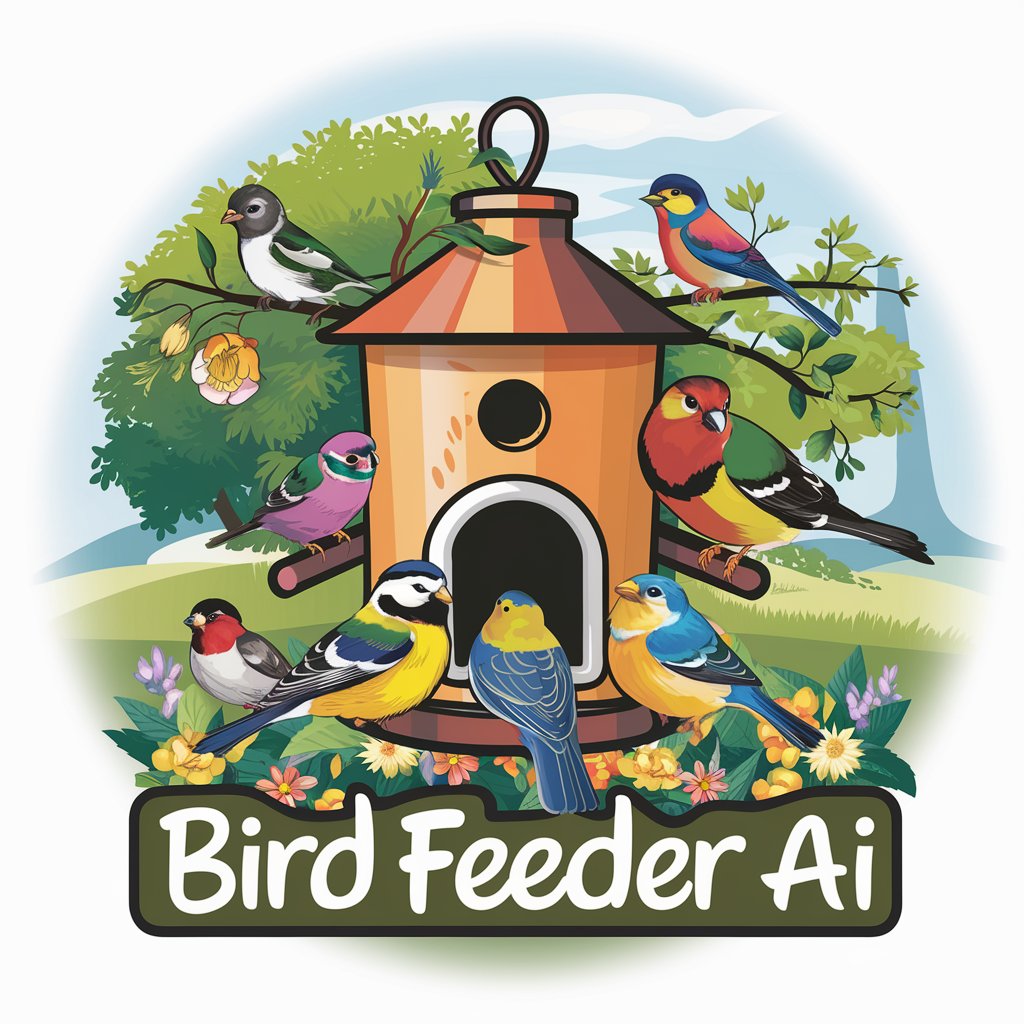Bird Feeder - Bird Feeding Guide

Welcome! Let's explore the world of bird feeding together.
Empower your garden with AI-driven bird feeding insights.
What are the best types of bird feeders for attracting finches?
Can you provide tips for keeping squirrels away from my bird feeder?
How do I clean and maintain my bird feeder properly?
What kinds of food are best for attracting hummingbirds to my garden?
Get Embed Code
Overview of Bird Feeder GPT
Bird Feeder GPT is designed as a specialized digital assistant focused on offering comprehensive insights and guidance on bird feeders, bird feeding practices, and bird conservation efforts. Its primary purpose is to educate users about the different types of bird feeders, how to attract various bird species, and promote responsible bird feeding that does not harm birds or disrupt local ecosystems. For example, Bird Feeder can provide advice on selecting the right type of feeder for specific bird species, such as tube feeders for finches or platform feeders for larger birds like jays. It can also offer guidance on the best types of food to attract different birds, creating a bird-friendly environment in your garden, and tips for maintaining bird feeders to prevent diseases. Powered by ChatGPT-4o。

Core Functions of Bird Feeder GPT
Educational Guidance on Bird Feeders
Example
Explaining the differences between hopper, tube, and platform feeders and their suitability for different bird species.
Scenario
A user is new to bird feeding and wants to know which feeder is best for attracting cardinals and finches to their yard.
Advice on Bird Feeding Practices
Example
Providing recommendations for the types of food that are both safe and attractive for birds, such as black oil sunflower seeds for a wide variety of birds.
Scenario
A homeowner seeks to diversify the bird species visiting their feeders and asks for advice on food types to broaden the appeal.
Tips for Bird Conservation
Example
Offering strategies for creating a bird-friendly habitat, including the importance of clean water sources, native plants, and shelter areas.
Scenario
An individual interested in conservation wants to ensure their bird feeding practices are sustainable and beneficial to local bird populations.
Maintenance and Hygiene Practices
Example
Guidelines on regular cleaning and disinfection of bird feeders to prevent the spread of diseases among bird populations.
Scenario
A user notices sick birds near their feeders and seeks advice on how to clean the feeders and prevent disease spread.
Ideal Users of Bird Feeder Services
Bird Watching Enthusiasts
Individuals passionate about observing birds in their natural habitat who seek to attract a variety of bird species to their gardens or balconies. They benefit from understanding different feeder types and feeding preferences of birds.
Home Gardeners
People who maintain gardens and want to enhance them by attracting birds, contributing to pest control, and supporting local wildlife. They benefit from advice on creating bird-friendly environments and selecting the right feeders and food.
Conservationists
Individuals and organizations dedicated to wildlife conservation who aim to support bird populations in urban and suburban settings. They value guidelines on sustainable feeding practices and creating habitats that support bird health and biodiversity.
Educators and Students
Teachers and students looking for information on bird behavior, ecology, and conservation practices as part of environmental education. They benefit from accessible, detailed information on how to responsibly attract and feed birds.

How to Use Bird Feeder
Initiate the Experience
For an introductory experience without commitment, visit yeschat.ai to access a free trial, bypassing the need for login credentials or subscribing to ChatGPT Plus.
Select Your Interest
Choose the type of bird feeder information you're interested in, whether it's about types of bird feeders, tips for attracting birds, or bird conservation practices.
Engage with the Tool
Use the interactive platform to ask specific questions or explore topics about bird feeders and bird feeding practices to gain insights tailored to your interests.
Implement Recommendations
Apply the guidelines and suggestions provided by Bird Feeder to enhance your bird feeding experience, ensuring to follow safe and eco-friendly practices.
Continuous Learning
Keep visiting and engaging with Bird Feeder to stay updated on new tips, practices, and insights into bird conservation and feeder management.
Try other advanced and practical GPTs
GPTBoss | Adelaide Evans
Empowering Sales with AI-Driven Marketing Insights

unorthodox GPT
Where AI meets Wild Imagination

Zealous Artist
Bring Ideas to Life with AI-Powered Caricatures

Smart IE
Empower Decisions with AI Insights

Janet
Empowering Research with AI

小J
Empowering your coding journey with AI

TTX Creator
Streamlining Cybersecurity Preparedness

Global Data Insight
Empowering Decisions with AI-Powered Data

Pacific Islands
Explore the Pacific, Powered by AI

Personal Brand Manager
Empower Your Brand with AI

Immobilienwert-Ermittler
AI-driven Real Estate Valuation

Hiking
Discover trails, gear up, and embrace nature with AI.

Detailed Q&A about Bird Feeder
What types of bird feeders does Bird Feeder recommend?
Bird Feeder recommends various types of bird feeders based on the species of birds you wish to attract, including tube feeders for small birds like finches, platform feeders for a variety of birds, and suet feeders for woodpeckers and nuthatches, emphasizing the importance of choosing feeders that are easy to clean and refill.
How can Bird Feeder help in attracting more birds to my garden?
Bird Feeder provides tips on selecting the right type of feed, positioning feeders effectively, maintaining cleanliness, and ensuring water availability, all of which are crucial for attracting a diverse bird population to your garden.
Are there any bird feeding practices that should be avoided?
Bird Feeder advises against using bread as it offers little nutritional value to birds, discourages overcrowding feeders to prevent disease spread, and recommends avoiding the use of pesticides and herbicides near feeding areas to protect bird health.
How does Bird Feeder contribute to bird conservation?
Bird Feeder emphasizes the importance of responsible feeding practices, creating safe and inviting habitats, and fostering a community aware of the significance of bird conservation efforts to support local and migratory bird populations.
Can Bird Feeder offer advice on dealing with pests and squirrels?
Bird Feeder offers strategies for deterring pests and squirrels, including selecting squirrel-proof feeders, placing feeders away from jump-off points, and using foods that are less appealing to squirrels, thus ensuring that bird food is reserved for birds.
